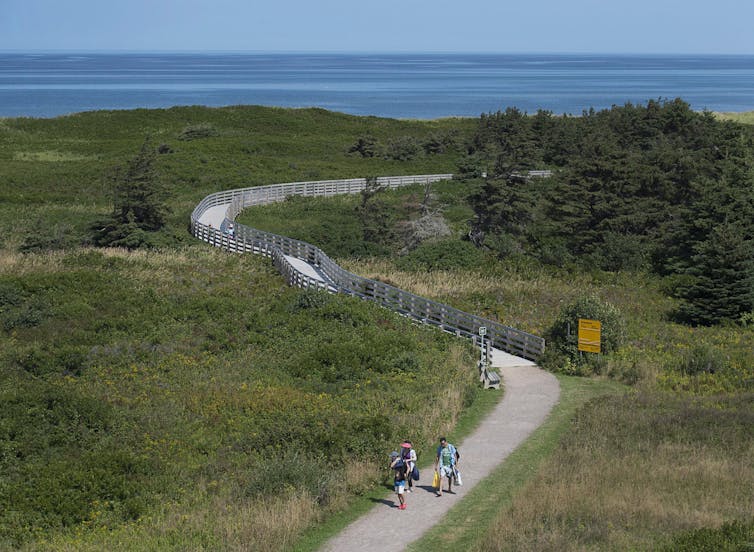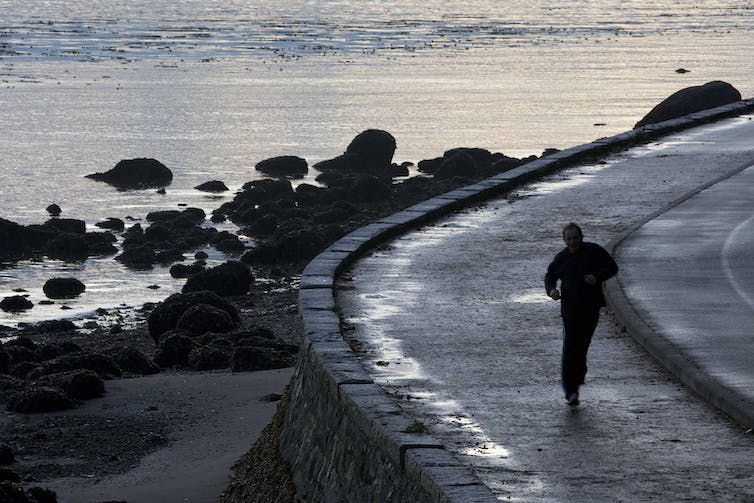Along Canadian coasts, storm surges and flooding have gone from breaking news to seasonal norms.
Phenomena Canadians have historically thought of as freak natural disasters are becoming regular predictable occurrences.
Our go-to solution to protect property and infrastructure is to build walls to block wave energy — walls that have become ineffective and unaffordable. It’s time to look beyond the status quo and consider nature-based solutions to protect the places we love.
How we got here
In many parts of the world, humans have long felt a strong connection to the coast. We write stories, sing songs and build lives on the lands that touch the sea. We also build walls and other concrete, stone and metal structures to protect those lands from the very seas we revere.
From time immemorial, Indigenous Peoples made their homes along the coasts, becoming experts in their knowledge of coastal ecosystems and, on the Atlantic and Pacific coasts, used salt marshes for food and transportation. Following European settlement, those salt marshes were drained, dykes were built from earth and wood, and the land was cultivated for agriculture.
Storms or sea-level rise – what really causes beach erosion?
Over time, other hard armour structures such as revetments and breakwaters were constructed to block wave energy and provide additional protection for agriculture, transportation and growing cities.
Where we are now
Today, Canada’s coastal infrastructure includes extensive networks of seawalls, dykes, revetments and breakwaters, most of which are made of hard materials. Hard coastal infrastructure is everywhere if you know where to look. The Canso Causeway connecting Cape Breton Island to mainland Nova Scotia and the Vancouver seawall are just two examples.
In some cases, using hard infrastructure is unavoidable. Indeed, hard infrastructure is critical for maintaining transportation and energy infrastructure, including roads, railroads and ports.
THE CANADIAN PRESS/Jonathan Hayward
However, hard infrastructure almost always increases erosion in adjacent areas, is expensive to maintain and degrades over time. Engineers predict that repairs, including raising the dykes along the Chignecto Isthmus between New Brunswick and Nova Scotia, will cost between $189-300 million.
With such an astronomical price tag, even smaller projects are simply not an option for many municipalities or individual landowners.
Coastal erosion is unstoppable – so how do we live with it?
In the face of such challenges, there are opportunities to adapt engineering and protective infrastructure to be more sustainable by integrating natural elements and processes.
Nature-based solutions
Nature-based approaches preserve or reintroduce natural structures and materials into the environment, recognizing and respecting natural systems and their benefits for humans.
Nature-based approaches range from those that are entirely natural to hybrid solutions, which incorporate traditional hard engineering with natural features.
Examples of nature-based solutions include dyke realignment to restore natural water flow and allow saltmarsh reestablishment, wetland and dune restoration, and living shorelines which utilize plants, sand and rock to protect the coast.
Nature-based approaches can involve reserving land for natural systems by protecting them from development and making room for the evolution of natural systems; they can also involve moving back from the coast, and releasing land back to nature.
Hard infrastructure weakens over time while nature-based solutions grow stronger as plants establish roots, biodiversity increases and natural processes adjust.
Nature-based solutions provide a wide array of benefits. In addition to protecting coastal places from flooding, storm surges and erosion. Nature-based solutions prevent shoreline pollution, support biodiversity, can increase property value and contribute to overall human well-being.

THE CANADIAN PRESS/Andrew Vaughan
Incorporating nature-based solutions requires innovation and open-mindedness that may feel intimidating and it is often easier to trust a stone or concrete wall over the energy absorbing power of plants and soil.
As such, raising awareness about different nature-based options and being transparent about costs and benefits can help build confidence in nature-based solutions.
Successful nature-based solutions also require place-based collaboration and knowledge sharing between impacted peoples, engineers, scientists and decision-makers that consider social
and ecological interests.
St. Lawrence shoreline erosion: We must work with, not against, nature
Nature-based solutions cannot be prescribed as top-down interventions. Every situation is unique, and many people with diverse knowledge and perspectives should come together to decide how specific nature-based approaches can meet various infrastructure, ecological and social needs as well as increase flood resilience.
What now?
For natural resource and permitting agencies, as well as many property owners, the tradition of building hard armoured shorelines remains deeply ingrained. Current guidance documents, policies and habits were built for hard infrastructure. In some cases, bureaucratic decision-making structures move slower than hazards from flooding.
In other cases, including lack of or delayed implementation of legislation, such as the Coastal Protection Act and regulations in Nova Scotia, political interests hinder planning actions that would limit hard infrastructure and development along the coast.
Many Canadians are buying homes in areas with high flood risk. The infrastructure they rely upon is aging and requires adaptation. Infrastructure supporting bridges, roads and rail lines needs to be upgraded or removed, providing opportunities to incorporate nature-based solutions.
Hope for the future
As we look towards what can feel like an ominous future, there are many resources for individuals or organisations seeking additional information and guidance about nature-based solutions. TransCoastal Adaptations: Centre for Nature-based Solutions is a practitioner, academic and government partnership in Nova Scotia focused on restoration, managed realignment and climate change adaptation.
Privately owned companies, also in Nova Scotia, Helping Heal Nature and CB Wetlands and Environmental Specialists, focus on ecological restoration, living shorelines and community stewardship and education. Nation-wide communities of practice exist to build capacity for natural and nature-based approaches.
As more people learn about nature-based solutions, there will be more opportunities to incorporate natural process into coastal protection. We know the stakes, and we have nature-based solutions at hand. It’s time to give dirt and plants a chance.




